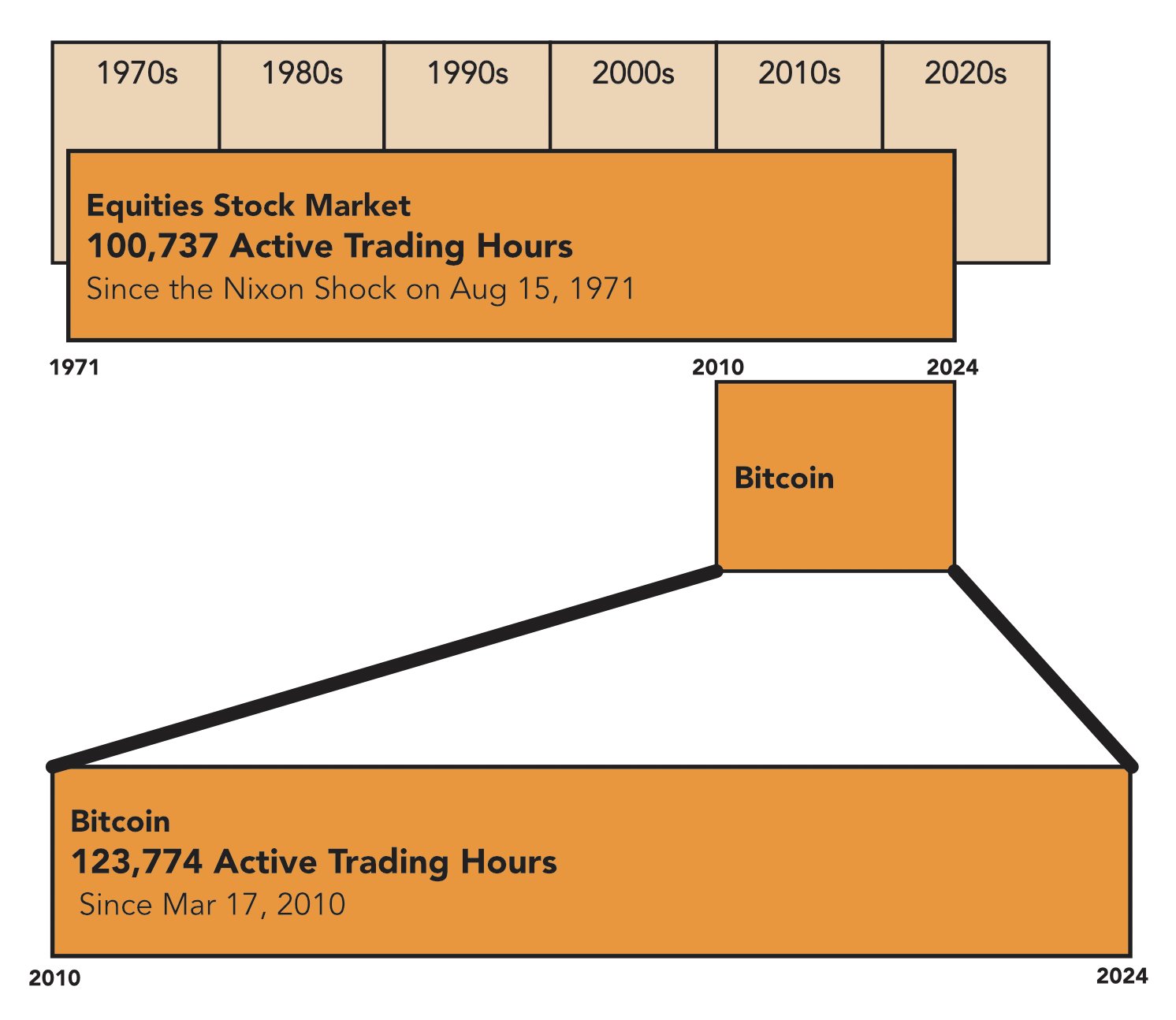While Bitcoin trading hours have exceeded those of the modern U.S. fiat stock market since the Nixon Shock, it would be premature to claim they have exceeded the entire history of U.S. stock trading or global fiat trading as a whole. Closer investigation reveals a more nuanced picture of market longevity and trading activity.
The crypto community was recently abuzz with statistics released by Corey Bates showing that Bitcoin trading times are now longer than the fiat stock market.

While Bates points out that Bitcoin trading is currently outperforming the fiat stock market, it’s important to remember that this doesn’t mean the entire history of the U.S. stock market. Still, we can see that Bitcoin trading predates fiat trading in the U.S., but not globally.
The earliest known use of legal tender currency dates back to the Song Dynasty in China (960-1279 AD), when governments issued paper money that was not backed by any physical commodity such as gold or silver. This currency was initially backed by the credit of the state and became widely accepted for trade and taxation.
Bitcoin Trading Hours vs. US Fiat Stock Market
Launched in 2009, Bitcoin has accumulated 123,774 active trading hours since the first recorded transaction on March 17, 2010. This is more than the 100,737 hours recorded in the U.S. stock market since August 15, 1971, when the Nixon Shock brought about major changes to the global financial system by abolishing the gold standard.
But the history of the U.S. stock market goes back much further than 1971. The New York Stock Exchange, founded in 1792, has been around for over two centuries. When you consider this history in its entirety, the picture changes dramatically.
Based on the NYSE’s founding date, that works out to roughly 380,509 active trading hours by September 6, 2024. This figure far exceeds Bitcoin’s current total, despite the digital asset’s 24/7 trading schedule.
Bitcoin has a significant advantage in stacking trading hours because it is available 24 hours a day. Traditional stock markets operate on a more limited schedule, typically 6.5 hours a day, five days a week, excluding holidays.
Considering Bitcoin’s ongoing trading, it is predicted that it will take until around April 15, 2053 for the digital asset to actually surpass the total trading hours of the entire history of the U.S. stock market. This assumes that both markets continue to operate on their current schedules without any major disruptions.
However, it is important to note that trading hours alone do not provide a complete picture of market depth, liquidity, and overall economic impact. The US stock market remains the linchpin of global finance, with Bitcoin yet to catch up in terms of depth and breadth of listed companies and trading volume.
Bitcoin has made impressive progress in its young years, but the weight of centuries of U.S. stock market history remains a powerful benchmark.
The complete history of fiat currency trading
Bitcoin is moving fast, but it will be decades before it can seriously claim to have surpassed the cumulative trading hours of any major U.S. stock market. Moreover, to gauge Bitcoin’s claim to have surpassed fiat currencies, the foreign exchange market has been available 24 hours a day on weekdays since 1971.
Estimating total fiat currency transaction times on a global scale poses unique challenges due to the historically gradual adoption of fiat monetary systems. Although fiat currencies have been in use in some form since ancient China, modern transaction times only became consistent in the 20th century, especially since the transition from the gold standard after the Nixon Shock in 1971.
Prior to 1971, global trading hours were localized, irregular, and varied from region to region. Even as fiat currency systems became more common, there was no unified global trading market and exchanges had limited opening hours. However, after 1971, the emergence of the foreign exchange (FX) market provided a more reliable benchmark for calculating trading hours.
Currently, modern Forex trading takes place approximately 120 hours per week (24 hours per day, 5 days per week). On this basis, it is estimated that fiat currencies have been traded approximately 6,240 hours per year since 1971. Over the 53 years from 1971 to 2024, there will be approximately 330,720 hours of fiat currency trading in the modern global market.
In summary, Bitcoin has outperformed the US fiat stock market since 1971 in terms of trading hours, but the cumulative trading hours of global fiat currency transactions since the inception of organized global foreign exchange markets are significantly longer.
Therefore, Bitcoin has not surpassed the combined total global trading hours of fiat currencies, both in terms of modern Forex trading and in terms of the long history that fiat currencies have had worldwide. Still, Bitcoin could theoretically eventually catch up, unless the major Forex markets are also open on weekends. However, some brokers do allow limited weekend trading on the most popular Forex pairs.
#Bitcoin #trading #older #fiat #currencies #stock #market